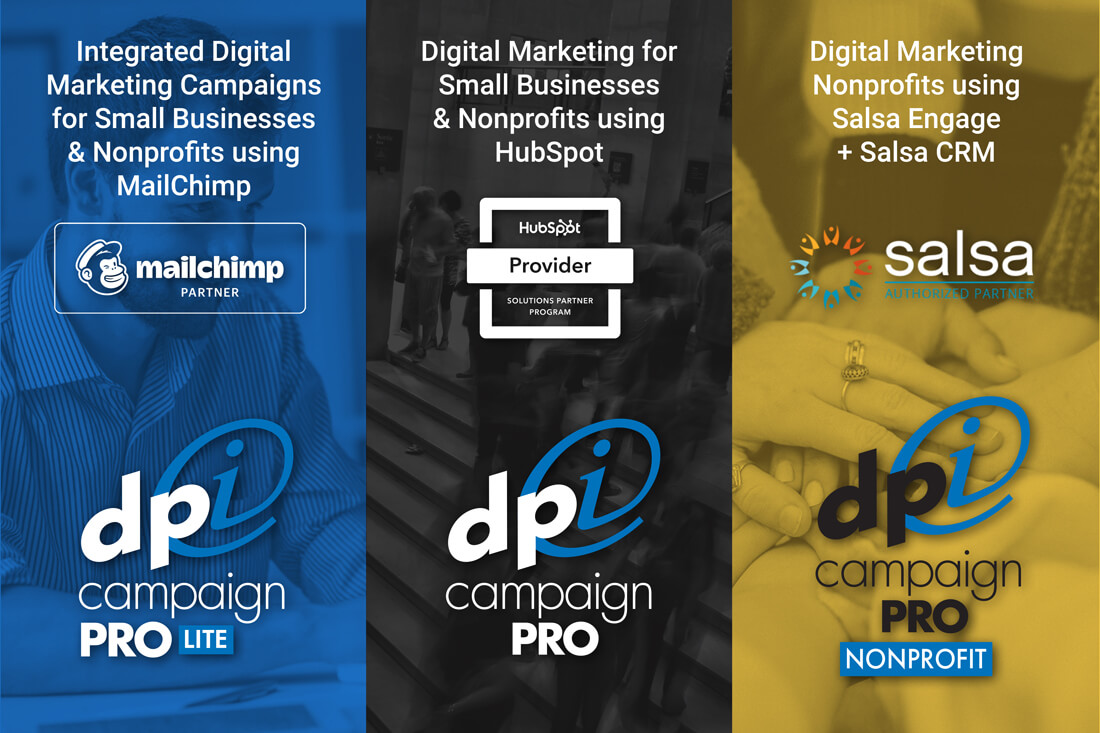What Is Digital Marketing?
Over the past year, we saw just how important having a digital marketing plan was. For some businesses and organizations, it was a step into uncharted territory – meetings via Zoom, people working from home, in-person events became online streaming sessions. The technology existed, but for the most part, people really weren’t using it fully or even widely. With an increase in people spending more time online, digital marketing began to play a much more important and larger role in business marketing plans.
Digital marketing isn’t new – it’s been used for years – email, online ads, social media and more. It’s not new, however, many businesses and nonprofits are just discovering it and its benefits. But what exactly IS digital marketing?
DIGITAL MARKETING BY DEFINITION
DIGITAL MARKETING PLAN BENEFITS
There are several benefits to using digital marketing as part of your overall marketing plan. Take note that I said “as part of your overall marketing plan” – simply put, while digital marketing has many benefits and the ease of using a digital marketing strategy to increase your profits has never been better, you should continue to have or put in place some traditional or non-digital marketing practices as well.
SOME BENEFITS OF HAVING A DIGITAL MARKETING PLAN
- Better ROI (Return on Investment)
- Measurement and Tracking
- Connecting with consumers where they are
- Targeting and demographics
Better ROI (Return on Investment)
Perhaps one of the biggest benefits of a digital marketing plan is the cost effectiveness of it. With traditional direct marketing, direct mail for instance, there’s the upfront cost of printing and postage and we can’t forget the potential for waste. Digital marketing allows businesses to reach and connect with consumers without having to spend on overhead like printing and postage. Instead, budgets are spent on impressions and clicks where their target market sees their media, can engage with it for more information or to make a purchase directly. This way, you spend money on the people who are actually interested in your product or service.
Measurement & Tracking
Digital marketing offers better measurement and tracking than traditional marketing. How? For starters, attribution. You can directly attribute conversions to what drove them. Given tools like Google Analytics and Google Search Console, you can attribute the search terms that brought a consumer to your landing page, the actions they took and how they converted. A CRM can further attribute those results and attach a dollar amount to the lead so that you can determine your cost per acquisition (CPA) as well as the value of the lead. Traditional marketing struggles with getting direct attribution with surveys and asking “how did you find us”, however, those methods are both unreliable.
Connecting with Consumers Where they Are
You’re not likely to find your target audience hanging out at a community bulletin board at the supermarket. You’re not likely to reach everyone with a direct mail campaign either due to deliverability issues or the recipient seeing it solely as junk mail. How do you reach them? Using a multichannel digital approach. Multichannel means just that – using multiple channels such as social media, podcasts, email and landing pages, video, etc. By reaching your customers where they are – on Facebook or Instagram, checking their email, or listening to a podcast at work or home, digital marketing expands the reach of traditional marketing exponentially when compared to traditional marketing alone.
Targeting & Demographics
Digital marketing is much easier and more accurate when it comes to targeting a specific persona and demographics. What would traditionally take time to narrow down the ideal customer using traditional marketing, can, with digital marketing, be done in a matter of minutes and with better accuracy. Additionally, digital marketing offers the ability to track and be able to target consumers based on what they’ve shopped for, whether they’ve added a product to their online cart but haven’t checked out, whether they’ve opened an email or not and the ability to resend an email just to the people who didn’t open the first email. This targeting is only made available through digital marketing.

WHY IS DIGITAL MARKETING IMPORTANT?
The importance of having a digital marketing plan is probably best illustrated by the events of the past year and a half. COVID-19 took over the world and forced everyone to be at home more, on devices more and online more. We spent so much time staying connected on social media, over email and through digital content that it’s hard to imagine how we would have gotten through 2020 without digital marketing.
Digital marketing has become such an important part of the “marketing mix” for every business – large and small. Nonprofits are using digital marketing for fundraising and staying in touch with members and donors. It helps connect consumers with businesses and develop relationships with them fostering customer loyalty.
For those who are environmentally conscious, digital marketing has a smaller carbon footprint than traditional marketing.
With all these reasons to have a digital marketing plan, why would anyone use traditional marketing? The important thing to remember is that traditional marketing is part of the multichannel marketing plan. It offers the methods that consumers have grown accustomed to while employing some newer technologies and methods as well.
WHAT IS CONSIDERED DIGITAL MARKETING?
TYPES OF DIGITAL MARKETING
- Social Media Marketing
- Content Marketing
- Search Engine Optimization (SEO)
- Email Marketing
- Marketing Automation
- Inbound Marketing
- Pay-Per-Click (PPC)
Social Media Marketing
As you probably already know, social media is where most people hang out – a staggering 145 minutes a day. This is why social media marketing is not only effective at reaching a variety of demographics, it reaches them where they spend most of their online time. Social networks like Facebook, Instagram, Twitter, LinkedIn, Snapchat and YouTube offer a variety of effective marketing features for reaching your target audience:
- Scheduled posts for business pages
- PPC ads & boosted posts
- Contests, Polls and Surveys
- Follower engagement & sharing
Social media marketing is currently the most popular content medium for B2C marketers, at 96% and even 61% of B2B marketers have increased their use of social media marketing over the past year.
Content Marketing
Content marketing runs a close second to social media marketing in terms of popularity. Content marketing is a form of digital marketing that uses digital content to promote services or products by providing assets and resources to drive traffic, generate leads and grow businesses. Common examples of content marketing include blogging, podcasts, whitepapers, ebooks and other lead magnet type resources.
Content marketing also helps create inbound links to your website, as well as driving traffic to landing pages. It helps assist in search engine optimization (SEO) by helping establish your website as an authoritative resource in the search engines.
Search Engine Optimization (SEO)
There are a number of ways to increase your website’s ranking in the search engines. And, while you should always make sure that your HTML markup is solid and your pages are rich with the keywords you want to rank for, you really should be optimizing for humans, not necessarily search engines. If your pages are well written, structured well (they have a H1, H2 , H3 hierarchy, etc.), load quickly and are responsive, it’ll help both your search engine ranking as well as how well your visitors consume your content.
While SEO could be it’s own topic for another blog post, the things that matter most are your site being rich with keywords and making sure your page sitemap is submitted to the search engines for indexing. Setting up Google Analytics, Google My Business, and submitting your sitemap to Google Search Console are the basics optimizing any website for search engines.
Email Marketing
Email marketing is another popular digital marketing method that helps reach a variety of audiences, right in their inbox. Services like Constant Contact and MailChimp have made it both affordable for small businesses and nonprofits alike to reach customers, members and donors with templated, well designed and responsive email marketing messages. Typically email marketing messages include e-newsletters, email nurturing or drip campaigns, welcome emails, follow-ups on downloads or purchases and more.
Email marketing has a wide variety of uses and has become an integral part of marketing automation. Email marketing, when used with marketing automation can help remind users of items in their shopping cart that they haven’t purchased yet, assist new customers with a how-to series on getting started or simply using it to send gated content after providing their email address.
Marketing Automation
Marketing automation takes over a lot of the correspondence and basic marketing operations that was previously done manually. As mentioned above, marketing automation can help with scheduling of posts and email campaigns, respond to a customer if they’ve “abandoned” their shopping cart, suggest products or services based on past buying history, provide a helpful email series to nurture them before or after a purchase. Depending on the platform your choose, some can even provided a meeting scheduler to avoid the back and forth of “what day is good for you?”
Marketing automation plays a huge role in the success of any digital marketing plan. Without having some simple processes automated, you would be inundated with all of the basic marketing tasks that need to be done daily to keep current customers and to prospect new ones.
Inbound Marketing
Inbound marketing is a marketing methodology that attracts customers by creating engaging and valuable content without being intrusive. Unlike outbound marketing, where the marketing message is “in your face” and cannot be ignored, inbound marketing seeks to create a relationship with the customer and provide helpful guidance at every stage of the buyer’s journey.
Three stages of inbound marketing are: attract, engage and delight. By attracting customers, you’re using any or all of the tactics above including content marketing to help begin building a relationship with them. You engage them by providing useful and helpful advice and solutions to help solve their specific problems. After you’ve attracted and engaged them, you can delight them by providing multiple areas for feedback so that they feel like their input matters and that they are more than just a sale. A customer relationship manager can assist in helping attract, engage and delight your customers regularly.
Pay-Per-Click (PPC)
While most digital marketing methods require little to know ongoing funding, pay-per-click (PPC) marketing is one option that does. PPC ads include but are not limited to Google Adwords, Google Display Ads, and Facebook and Twitter Ads. These ad types vary in requirements to run the ad, as well as the cost per click, which will depend mostly on your search terms and demographics.
There are varying thoughts regarding whether to run a PPC campaign or not, I tend to lean on not running too many, personally. Often, I find that the ROI isn’t great with paid ads. In many instances, I question myself about a campaign, “would I click on this ad?” If the answer is no, then the ad needs to be revised or campaign scrapped completely.

HOW DO I START A DIGITAL MARKETING CAMPAIGN?
The first step in any marketing program is to come up with a plan. Digital marketing encompasses a wide array of strategies and services and you’ll want to nail down what aspects of digital marketing should be part of your plan. In general, the following steps should get your started on the right path:
DIGITAL MARKETING CAMPAIGN STEPS
- Set your campaign goals.
- Identify your target audience.
- Determine your digital marketing strategy.
- Create content & resources.
- Establish and optimize for keywords.
- Launch!
- Revise and re-launch as necessary.
Set your campaign goals
Before you can create any kind of campaign or determine what medium you’re going to use, you need to start with a goal. What do you want your digital marketing campaign to do? Generate leads? Nurture new customers? Connect with current customers?
How will you measure its success? X number of new customers? X dollars in new sales? It’s imperative that goals are set and that there’s a quantifiable way to measure them or else setting the goal is meaningless.
Identify your target audience
Now that you have your goal set and it’s measurable, you’ll need to identify who you want to target with your digital marketing campaign. You should already have an idea of who your target audience will be for this campaign, as it is probably partly defined in your goal. Nonetheless, but specific when determining who exactly you’re targeting with your campaign.
Determine your digital marketing strategy
This one could be challenging – if you don’t know anything about your target audience (IE their communication preferences, where the spend their time online, etc.) then this will most likely be difficult to determine. However, if you know, from say, past experiences, that your target audience responds well to email marketing, but had a lukewarm response to social media marketing, focus your efforts on email marketing. Don’t omit social media marketing altogether – just focus your efforts on making your marketing automation with your email marketing the best it can be and use social to supplement your email marketing efforts.
In determining your digital marketing strategy, it’s not recommended that you put all your eggs in one basket and focus solely on one method of digital marketing. Rather, choose a primary method and supplement the primary method with additional marketing messages that support the campaign as a whole.
If you don’t have any data on your target audience and don’t know how they’ll respond, or if you do and the response is a mix, then allocate resources equally to ensure that your digital marketing coverage touches each digital marketing type. Once you start getting data and response, make changes accordingly.
A digital marketing strategy is something that should be revisited from campaign to campaign. What worked before, may not work now OR you goals may be different. Make sure you’re not using a one-size-fits-all strategy and that it’s at least reviewed before starting a new campaign.
Create content and resources
Now you can begin creating the content you’ll be sharing with your target audience. Just as you’re planning to target a certain audience with your strategy, your content and resources should appeal to and be relevant to that audience. Make sure any digital assets or resources that may be gated are trackable and that the appropriate tracking is in place. Test the content on multiple devices to ensure that the user experience is just as good on a phone as it is on a desktop. Most of all, ensure that the content makes sense – would you read or download the resource? Is the offer/incentive relevant to the target audience? Does the verbiage in the content make sense?
Establish and optimize for keywords
Once your content is created, you’ll need to research keywords (if you haven’t already) and establish keywords for any pages, posts or resources that you’ve created content for. You’ll want to optimize those resources as well – go through, after they’ve been written, created and published and make sure they are rich with the keywords you’ve chosen. This may require some rewriting, however, it’s necessary. Once you’ve optimized your content and your ready to publish or republish, do so, and then submit your post or page sitemap to Google Console for indexing. It’ll then get on Google’s radar that you’ve got new content and that it’s ready for human consumption.
Launch!
It’s been said that “you don’t learn until you launch.” And, it’s true. You can prepare and review and optimize all day long but you won’t know a thing about whether the campaign will be a success if you don’t launch it. I believe that once you have content that is ready to go, publish it and get it out there. You can edit on the fly. The longer you take tweaking and making changes until it’s just right, the longer it’s going to take for people to find your content. You don’t learn until you launch. So, go ahead and do it!
Revise and Re-Launch as necessary
As stated above, you’re bound to start learning about how successful your campaign is almost immediately after launching. The data you collect will, hopefully, be actionable and you can edit your campaign accordingly. It’s important to revise mid-campaign because it could make the difference between a complete bust or a wildly successful campaign. Keep an eye on the results and review them as often as it appears necessary to do so. If your campaign needs to pause to make considerable edits, then so be it, but don’t forget to re-launch when you’re done!
I’M READY, NOW WHAT?
Digital marketing is unlike traditional marketing in that anyone can do it – it requires very little resources, you don’t need a business or organization with a huge budget, and it doesn’t take weeks of setup time. Once you’ve gotten the basics down, it’s not super difficult to just start running campaigns. As I said above you don’t learn until you launch – and you really won’t understand or know how to do digital marketing if you don’t just jump in and start.
SIGNUP FOR OUR EMAIL NEWSLETTER!






